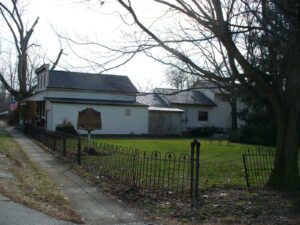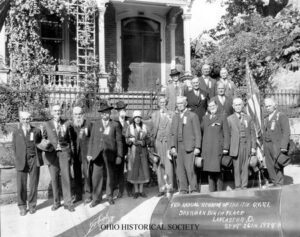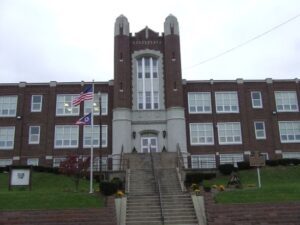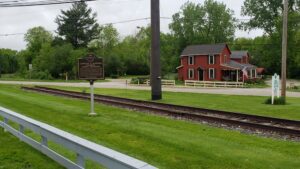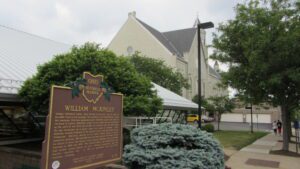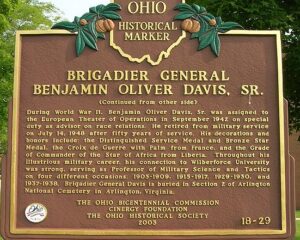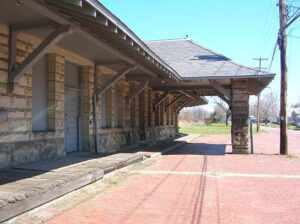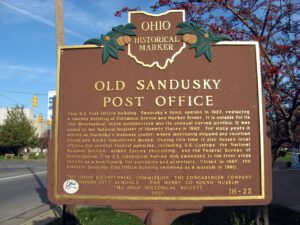, OH
The foundation for the first Welsh settlement in Ohio was laid on June 29, 1801, when William and Morgan Gwilym purchased land in what is now Morgan Township at the Cincinnati Land Office. The Welsh, who settled in Pennsylvania beginning in the late eighteenth century, moved westward and settled here in 1802. This area was also the major terminus for the 1818 migration from Montgomeryshire and Cardiganshire in Wales. In 1803 a Congregational Church was organized and services were held in members’ homes or outdoors. A brick Meetinghouse, complete with a Welsh death door leading to the cemetery, was constructed in 1824. The building now serves as the Community House. The present brick church was built in 1854. For many years, the library, formed in 1852, was housed in the New London Special School District building that stood on this site. (Continued on other side)
, OH
The 17th Infantry, created by Congress in 1812 and formed with personnel from western states, was the only Regular Army regiment in General James Winchester’s column of the Army of the Northwest’s campaign to regain Detroit. During the War of 1812, the 17th fought at Frenchtown, Fort Meigs, Fort Stephenson, and Thames River. In 1815, the 17th was consolidated with the 5th, 19th, and 28th Infantry to form the 3rd Infantry. In May 1861, the 17th Infantry was again organized as a Regular Army regiment and has since served continuously with distinction.
, OH
An October 23, 1927, ceremony was held for the laying of the cornerstone for the Dennison High School Building. It opened in the fall of 1928 and was called “Angel’s Castle” in honor of school superintendent William Hiram Angel. The building was designed by J.K. Griffin, an architect from Canton, Ohio, in a style that has the elements of Collegiate Gothic that was popular for school and college buildings during the early twentieth century. The distinguishing architectural features of the entrance towers enhance the school’s prominent location above the street level. Dennison High School is an important visual landmark in the community, as its towers are visible from the downtown area and surrounding neighborhoods. It has retained its integrity of location, materials, design, and association and conveys the early twentieth century ideals of education that the original design of the building was intended to inspire. (Continued on other side)
, OH
The Randall Secondary rail line dates to the 1850s when the independent Cleveland & Mahoning Railroad (C&M) laid tracks through Aurora, Ohio. C&M, chartered in 1848, linked the Mahoning Valley coal and iron ore fields to the industries and lake port at Cleveland. For over a century, the Randall Secondary contributed to Aurora’s economic life ? fueling the region’s rapid growth during the late 19th and early 20th centuries. In its heyday, the line was an important route for commuter transport and freight service along the 67 miles between Cleveland and Youngstown. Although passenger service into Aurora Train Station stopped in the 1960s, freight service continued into the 1990s. The last remaining track of the Randall Secondary in Aurora stands near the station it served.
, OH
William McKinley’s house, once located at this site, was the scene of his 1896 front porch campaign for President of the United States. During the campaign McKinley addressed about 750,000 people who came to his home in Canton. McKinley’s public service began when he volunteered at the start of the Civil War in 1861 as a private with the Union Army. He was discharged as a major after four years of service. Later McKinley became President of the Canton Y.M.C.A. and the Stark County Prosecutor. McKinley served in the United States House of Representatives between 1877 and 1891 and was then elected Governor of Ohio. He helped to found the Canton Public Library. McKinley won presidential elections in 1896 and 1900. His administration was characterized by high tariffs, money backed by gold, national prosperity, and the Spanish-American War. In 1901 an anarchist shot and killed President McKinley.
, OH
Benjamin Oliver Davis, Sr. (July 1, 1877 – November 26, 1970), the nation’s first African American general in the Regular Army, was born in Washington, D.C. Davis first served as a temporary first lieutenant of the 8th U.S. Volunteer Infantry during the Spanish-American War. Following that conflict, he enlisted as a private in the 9th U.S. Cavalry, serving in the Philippine Insurrection where he began to rise in rank. Davis was promoted to first lieutenant in 1905, captain in 1915, lieutenant colonel in 1920, colonel in 1930, and brigadier general in 1941. His military career took him around the world. In 1909, he was detailed as Military Attache to Monrovia, Liberia. During World War I, Davis was stationed in the Philippines. In 1938, he took command of the New York’s African American 396th National Guard Infantry, later known as the 369th Coast Artillery (Antiaircraft) Regiment. (Continued on other side)
, OH
On February 8, 1848, the Ohio Legislature incorporated the Cleveland, Painesville, and Ashtabula Railroad Company, which reached Painesville in 1851, with track and a depot. President-elect Abraham Lincoln arrived in Painesville on February 16, 1861, on his way to his inauguration in Washington, DC. The Lake Shore Railroad Company replaced the Cleveland, Painesville, and Ashtabula Railroad Company in March 1869 followed by consolidation with the Lake Shore and Michigan Southern Railway Company in June of that year. The Lake Shore and Michigan Southern Railway, replacing the original 1851 depot, built the present station in 1893. With its Richardson Romanesque style architecture, sandstone walls, slate roof, red oak and marble interior, and its hanging chandeliers, it was considered the jewel of Painesville. In 1914, Lake Shore merged with ten others to form the New York Central System. In 1971, the last passenger train left the Painesville yard, ending nearly 100 years of passenger rail service.
, OH
This U.S. Post Office building, Sandusky’s third, opened in 1927, replacing a smaller building at Columbus Avenue and Market Street. It is notable for its fine Neoclassical-style architecture and its unusual curved portico. It was added to the National Register of Historic Places in 1982. For sixty years it served as Sandusky’s business center, where merchants shipped and received goods and banks transferred money. During this time it also housed local offices for several federal agencies, including U.S. Customs, the National Weather Service, armed forces recruiting, and the Federal Bureau of Investigation. The U.S. Geological Survey disk embedded in the front steps serves as a benchmark for surveyors and scientists. Closed in 1987, the historic Sandusky Post Office building reopened as a museum in 1990.


